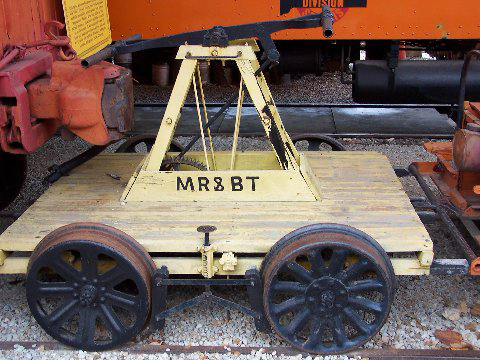Our Railroad - "I Won't Hire a Man Who Has All 10 Fingers!"
"...Early U.S. railroads used a link and pin coupling that was extremely dangerous
to yard employees who had to drop the pins in place as the cars were pushed
together..." [Encyclopedia Britannica].
“If you didn't get your timing just right, you lost a finger (or hand) if the locomotive bumped the cars together too hard. Not
the job for "Practice makes Perfect".
FELA would not arrive
until 1908. Finally, in 1880 the 'knuckle' type automatic coupler began to replace 'link and pin' bringing far greater safety
to the railroad industry [workers]. ”
EXHIBIT: Pictures of Tunnel Station and Valles Mines Station in our
Lost History Museum.
Gandy Dancers
A typical railcar can hold the load of three 18-wheeler over-the-road truck so they carry a lot of wieght. But how do they stay on track?
Railroad workers set them that way and specialist crews called "gandy dancers" for how they worked in chorus to align rails and
spiked the rails to the ties by hand. Repairs meant prying the spikes up by hand and by hand tamping the ballast, the loose rock
that helps to spread the load on the ties. Ties are wood, sawn from strong trees and have to be to keep the rails in place day
after day and load after load. Ties are spiked down through tie plates to keep the rails 'in guage' (4' 8" apart) or the train
derails. Rails must stay the same distance apart for miles so someone on the crew used to put a guage bar down on the rails to
check.
Nowadays machines are used instead, such as a Tie Layer, Tamper and Regulator. The Tamper raises the track while its paddles go
down the sides of the ties and push more ballast under the tie. Rails perfectly laid by machine today protrude only 1" out of the
ballast. Then the Regulator sweeps the loose leftover material and vibrates it leaving a beautiful roadbed. But for centuries
all this work was done by hand.
"...It was as an adventure that mechanically-powered railroading began - actually on a wager. A Cornish iron-mill owner bet 500
guineas that a steam engine could be devised that would haul ten tons of iron the nine-mile length of the Penydarran tramway;
then he engaged mining engineer Richard Trevithick to prove him right. The result was a small, sturdy locomotive that rolled
over the course with a string of what were normally horse-drawn cars, carrying ten tons of iron and 70 men..."
from "Railroads, The Great American Adventure", National Geographic Society 1977

Exhibited at the
Museum of Transport in St. Louis County, this handcar was used on our rail line.